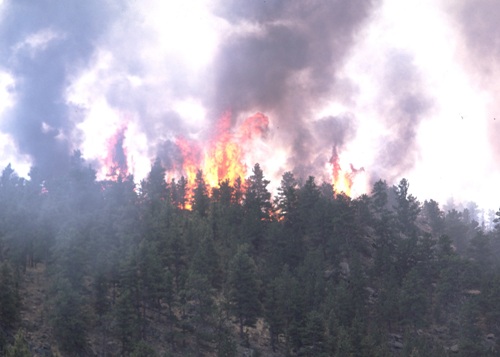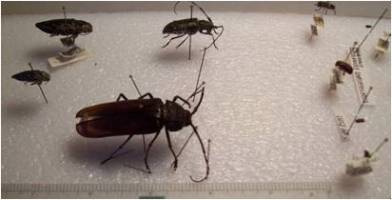Written by Tom DeGomez, University of Arizona
Forest disease organisms and abiotic occurrences that lead to diseased trees are common in terrestrial ecosystems. Most of the disease organisms within forests are essential to the health of the system and are present at background levels, generally occurring on weakened members within a forest stand. Occasionally, diseases can overcome a forest system and a stand-replacing event will occur, but this is a rare event even in the least resilient forests. The full …
Climate Change Impacts on Forest Insects
Excerpt from: Régnière, J. 2009. Predicting insect continental distributions from species physiology. Unasylva. 60:37-42.
Insects constitute the most diverse form of animal life in terrestrial ecosystems. Most species are innocuous but essential components of natural ecosystems. Because they are cold-blooded, the rates of key physiological processes in their life cycles are determined by environmental conditions, especially temperature and precipitation. In general they have short generation times, high fecundity, and high mobility (either through their own faculties or aided by wind, …
Wildfire and Climate
Adapted from: Rogstad, Alix; Crimmins, Michael; and Garfin, Gregg. 2006. Climate change and wildfire impacts in Southwest forests and woodlands. University of Arizona College of Agriculture and Life Sciences. Publication No. az1425
Wildfire requires three things to burn: an ignition source, fuel, and oxygen. If one of the three requirements is removed, the fire activity will be …
How a Changing Climate Can Affect Tree Health
Written by Eli Sagor
A changing climate will affect different forest stands in different ways, depending on a wide variety of factors including stand vigor, species and age class diversity, soils, water availability, and the ways that climate changes. For example, reduced soil moisture as a result of changing rainfall patterns will affect some species differently than others.
Here is what we know:
- The trees thriving in a given forest stand are well adapted to the current and recent
Wildlife Concerns and Climate Change
Adapted from: Ruggiero, Len; McKelvey, Kevin; Squires, John; Block, William. 2008. Wildlife and Climate Change. (May 20, 2008). U.S. Department of Agriculture, Forest Service, Climate Change Resource Center. http://www.fs.fed.us/ccrc/topics/wildlife.shtml
Issue
Climate change likely will lead to the loss of native species from extensive areas and result in increasingly scarce and fragmented populations in many others. Further changes within ecosystems will be triggered as invasive species, both plant and animal, fill the “holes” that are left as native species are …
Climate Change Impacts on Hydrology
Adapted from: Gucinski, H. 2007. Terrestrial and aquatic natural ecosystems: potential responses to global climate change. p. 41-66. In: Joyce, L., R. Haynes, R. White, R. Barbour, and R. James (eds.). Bringing climate change into natural resource management: proceedings. Gen. Tech. Rep. PNW-GTR-706. Portland, OR: U.S. Department of Agriculture, Forest Service, Pacific Northwest Research Station, 150 p.
Understanding the responses of aquatic ecosystems to climate change requires understanding how climate affects the hydrology of streams, rivers, and lakes. Aquatic habitats …
Ecosystem-Based Effects
Written by Melanie Lenart, University of Arizona
Climate largely defines where ecosystems occur on the landscape, from deserts to wetlands and tropical forests to tundra. So it’s clear that changes in climate will mean changes in ecosystems around the globe. Not all ecosystems will be displaced, but they all will face potential disruptions and the likelihood of increased disturbance from changing fire regimes and invasions of insects and exotic species.
Some of the specific challenges facing forest ecosystems are described …
Soils and Climate Change
Written by Sabrina Kleinman, University of Arizona
While the majority of climate change impacts on forests focus on tree health, soil impacts should not be overlooked. A changing climate can impact nutrient cycling, ecosystem respiration, and the storage of carbon in forests. While global models predict that climate change can increase global net primary production (NPP), regional variations in climate, nutrient availability, and water will have the largest impact on tree growth locally (Melillo et al. 1993). Most research …
Biodiversity and Climate Change
 Climate change poses a significant threat to biological diversity in forests. Learn the major changes that are expected.
Climate change poses a significant threat to biological diversity in forests. Learn the major changes that are expected.
Adapted from: Manley, P. 2008. Biodiversity and Climate Change. (May 20, 2008). U.S. Department of Agriculture, Forest Service, Climate Change Resource Center. http://www.fs.fed.us/ccrc/topics/biodiversity.shtml
Issues
Biological diversity is essential to maintaining ecosystem processes and services. Climate change poses a significant threat to biological diversity (Parmesan and Yohe 2003). Before climate change became an acknowledged threat, biological diversity was considered at risk at regional …
Insects in Forests
Written by Peter Kolb, Montana State University
Insects perform many roles within forests as pollinators, herbivores, carnivores, decomposers, and food sources for other organisms. As a group, they are the most abundant and important group in the phylum Arthropoda, and by 1972 more than 900,000 species had already been …


